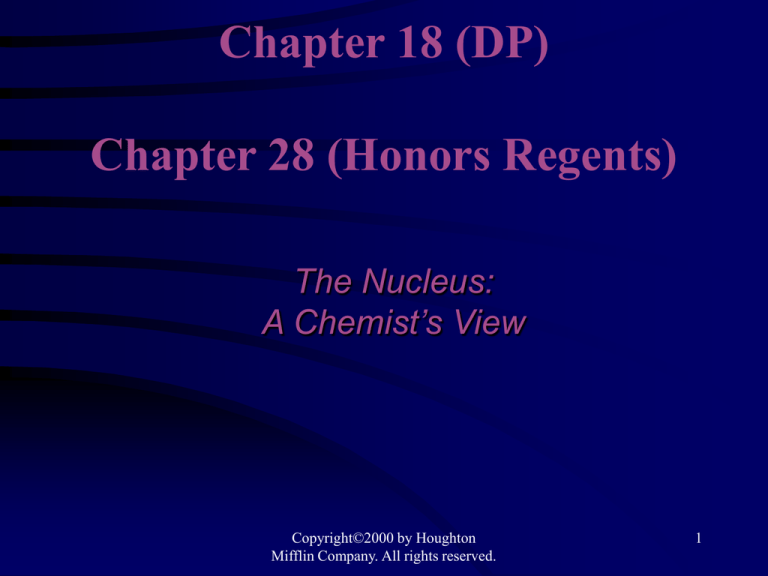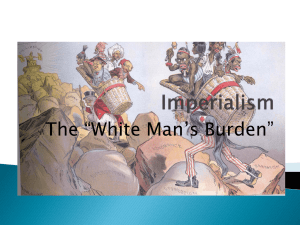
Chapter 18 (DP)
Chapter 28 (Honors Regents)
The Nucleus:
A Chemist’s View
Copyright©2000 by Houghton
Mifflin Company. All rights reserved.
1
The zone of
stability.
Copyright©2000 by Houghton
Mifflin Company. All rights reserved.
3
Characteristics of Some Ionizing Radiations
Property
Alpha Radiation
Beta Radiation
Gamma
Radiation
Composition
Helium Nucleus
Free Electron
High Energy EM
Radiation
Symbol
4
2
He
0
1
e
0
0
Charge
+2
-1
0
Mass (amu)
4
1/1837
0
Common Source
Radium-226
Carbon-14
Cobalt-60
Energy
8 x 10-13 J
8 x 10-15 J
1.8 x 10-13 J
Penetrating Power
Low
(0.05 mm body tissue)
Paper, clothing
Medium
(4 mm body tissue)
Metal Foil
High
(goes through the body)
Lead & Concrete
Shielding
Copyright©2000 by Houghton
Mifflin Company. All rights reserved.
4
Copyright©2000 by Houghton
Mifflin Company. All rights reserved.
5
Effect of Charge on Nuclear Particles
Copyright©2000 by Houghton
Mifflin Company. All rights reserved.
6
Nuclear Transmutation
(artificial shown here)
The change of one element into another.
27
13 Al
249
98 Cf
4
30
2 He 15 P
18
263
8 O 106 X
Copyright©2000 by Houghton
Mifflin Company. All rights reserved.
1
0n
1
40 n
7
Types of Radioactive Decay
(natural transmutation)
alpha production (): helium nucleus, 24 He
238
4
U
92
2 He
234
90Th
beta production (): 10 e
234
234
90Th 91Pa
0
1e
Copyright©2000 by Houghton
Mifflin Company. All rights reserved.
8
More Types of Radioactive Decay
(natural transmutation)
gamma ray production ():
238
4
234
0
U
He
Th
2
92
2
90
0
positron production:
0
1e
22
0
Na
11
1e
22
10 Ne
Copyright©2000 by Houghton
Mifflin Company. All rights reserved.
9
Check Regents Table O for Nuclear Chemistry Symbols!!!
Copyright©2000 by Houghton
Mifflin Company. All rights reserved.
10
Practice Balancing Nuclear Rxns
27
13
Al + He Si + ?
4
2
214
83
27
14
30
14
Bi He + ?
4
2
Si e + ?
0
-1
Cu Zn + ?
66
29
66
30
Copyright©2000 by Houghton
Mifflin Company. All rights reserved.
11
Decay Series
A radioactive nucleus reaches a
stable state by a series of steps.
series of decays 208
232
82 Pb
90Th
Copyright©2000 by Houghton
Mifflin Company. All rights reserved.
12
The decay
series from
U to Pb.
238
92
206
82
Rate of Decay
rate = kN
The rate of decay is proportional to the
number of nuclides. This represents a firstorder process.
Copyright©2000 by Houghton
Mifflin Company. All rights reserved.
14
Half-Life
. . . the time required for the number of nuclides to
reach half the original value (N0/2).
ln(2) 0.693
t1/ 2
k
k
Check Regents Reference Table N for Half-Lives!
Copyright©2000 by Houghton
Mifflin Company. All rights reserved.
15
Simplified Half-Life Equation:
A
A
0
1
2
n
Where A0 = original sample mass
A = final sample mass
n = number of half-lives
Copyright©2000 by Houghton
Mifflin Company. All rights reserved.
16
The decay of a 10.0-g sample of strontium-90 over
time. Note that the half-life is a constant 28.8 years.
Copyright©2000 by Houghton
Mifflin Company. All rights reserved.
17
238
92
The change in the amount of
Mo with time (t1/2 = 67 h).
Copyright©2000 by Houghton
Mifflin Company. All rights reserved.
18
19
Researcher
taking a bone
sample
for carbon-14
dating at an
archeological
site in Egypt.
Atom “Smashers”
Schematic diagram of a linear accelerator.
Copyright©2000 by Houghton
Mifflin Company. All rights reserved.
21
A schematic diagram of a cyclotron.
Copyright©2000 by Houghton
Mifflin Company. All rights reserved.
22
Copyright©2000 by Houghton
Mifflin Company. All rights reserved.
23
An aerial view of Fermilab, a high energy
particle accelerator in Batavia, Illinois.
Copyright©2000 by Houghton
Mifflin Company. All rights reserved.
24
Energy and Mass
When a system gains or loses energy it also
gains or loses a quantity of mass.
E = mc2
E
2 m
c
m = mass defect
E = change in energy
If E = (exothermic), mass is lost from the system.
Copyright©2000 by Houghton
Mifflin Company. All rights reserved.
25
Nuclear Fission and Fusion
Fusion: Combining two light nuclei to form a
heavier, more stable nucleus.
3
2 He
11H 24 He 01e
Fission: Splitting a heavy nucleus into two
nuclei with smaller mass numbers.
1
0n
235
142
U
92
56 Ba
91
36 Kr
Copyright©2000 by Houghton
Mifflin Company. All rights reserved.
301 n
26
Fission Processes
A self-sustaining fission process is called a
chain reaction.
Neutrons
Causing
Event
Fission
subcritical
<1
critical
=1
supercritical
>1
Result
reaction stops
sustained reaction
violent explosion
Copyright©2000 by Houghton
Mifflin Company. All rights reserved.
27
On capturing a neutron, the nucleus
undergoes fission to produce two lighter
nuclides, free neutrons (typically three), and a
large amount of energy.
Copyright©2000 by Houghton
Mifflin Company. All rights reserved.
28
Representation of a fission process in which each event
produces two neutrons, which can go on to split other nuclei,
leading to a self-sustaining chain reaction.
Copyright©2000 by Houghton
Mifflin Company. All rights reserved.
29
If the mass of fissionable material is too small, most of
the neutrons escape before causing another fission
event, and the process dies out.
Copyright©2000 by Houghton
Mifflin Company. All rights reserved.
30
Key Parts of a Fission Reactor
Reactor Core: 3% U-235 plus moderator +
control rods
Moderator (slows down neutrons – carbon or D2O)
Control Rods (captures neutrons - cadmium based
steel)
Coolant (deuterium oxide = heavy water or molten
sodium)
Containment
Shell (concrete & lead)
Copyright©2000 by Houghton
Mifflin Company. All rights reserved.
31
A schematic of a
reactor core.
The position of
the control rods
determines the
level of energy
production by
regulating the
amount of
fission taking
place.
A schematic diagram of a nuclear power plant.
Copyright©2000 by Houghton
Mifflin Company. All rights reserved.
33
Breeder Reactors
Fissionable fuel is produced while the reactor
runs ( 235
is
split,
giving
neutrons
for
the
U
92
creation of 239
):
94 Pu
1
0n
238
239
92 U 92 U
239
239
U
92
93 Np
239
239
93 Np 94 Pu
0
1 e
0
1 e
Copyright©2000 by Houghton
Mifflin Company. All rights reserved.
34
Copyright©2000 by Houghton
Mifflin Company. All rights reserved.
35
Copyright©2000 by Houghton
Mifflin Company. All rights reserved.
36
Biological Effects of Radiation
. . . depend on:
1.
2.
3.
4.
Energy of the radiation
Penetration ability of the radiation
Ionizing ability of the radiation
Chemical properties of the radiation source
Copyright©2000 by Houghton
Mifflin Company. All rights reserved.
37
A schematic representation of a
Geiger-Müller counter.
Copyright©2000 by Houghton
Mifflin Company. All rights reserved.
38
After consumption of Na131l, the patient's thyroid is
scanned for radioactivity levels to determine the
efficiency of iodine absorption. (left) A normal
thyroid. (right) An enlarged thyroid.
Copyright©2000 by Houghton
Mifflin Company. All rights reserved.
39
The two models for radiation damage. In the linear model, even a small
dosage causes a proportional risk. In the threshold model, risk begins
only after a certain dosage.
Copyright©2000 by Houghton
Mifflin Company. All rights reserved.
40
Copyright©2000 by Houghton
Mifflin Company. All rights reserved.
41
Copyright©2000 by Houghton
Mifflin Company. All rights reserved.
42
43
Copyright©2000 by Houghton
Mifflin Company. All rights reserved.
44
Ionizing Radiation Used to Cure Cancer
Copyright©2000 by Houghton
Mifflin Company. All rights reserved.
45
Skin Cancer From Sunlight
Copyright©2000 by Houghton
Mifflin Company. All rights reserved.
46







